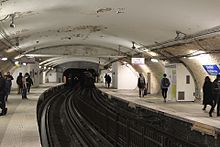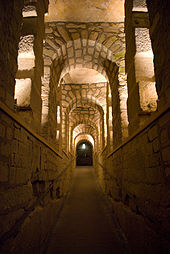Denfert-Rochereau (Métro Paris)
|
Colonel Rol-Tanguy |
|
|---|---|

|
|
| Tariff zone | 1 |
| Line (s) |
|
| place | 14th arrondissement |
| opening | April 24, 1906 |
Denfert-Rochereau is an underground transfer station for lines 4 and 6 of the Paris Métro . You can change to line B of the S-Bahn- like RER network at the Gare de Denfert-Rochereau station, which is located in the immediate vicinity .
location
The metro station is located on the border of the Quartier du Montparnasse and the Quartier du Petit-Montrouge in the 14th arrondissement of Paris . The station of line 4 is located southwest of the Place Denfert-Rochereau under the avenue du Général-Leclerc , that of the line 6 under the square and the confluence of the Boulevard Saint-Jacques.
Surname
Place Denfert-Rochereau gives its name. The Colonel Pierre Marie Philippe Aristide Denfert-Rochereau (1823-1878) gained his role in defending the fortress Belfort in the Franco-German War 1870-71 celebrity.
After the Avenue du Colonel-Henri-Rol-Tanguy, which crosses Place Denfert-Rochereau, the station carries the suffix Colonel Rol-Tanguy. Henri Rol-Tanguy (1908–2002) was one of the organizers of the French resistance in World War II . In the course of the liberation of Paris on August 25, 1944, together with General Leclerc, he received the declaration of surrender from the German General Dietrich von Choltitz .
history
The station of today's line 6 went into operation on April 24, 1906 with the opening of the extension of line 2 Sud from Passy to Place d'Italie . On October 14, 1907, the previously independent line 2 Sud was given up and moved to the southwestern end of line 5 ( Étoile - Gare du Nord ). Line 6 has been operating at the station since October 6, 1942, and in July 1974 this line was rebuilt for use with pneumatic trains .
The station on line 4 was opened on October 30, 1909. The line initially consisted of two spatially separated parts, a northern section opened in 1908 and a section south of the Seine , which ran from Porte d'Orléans to Raspail . On January 9, 1910, the extension to Châtelet went into operation, which connected the two sections.
description
Both stations are located under elliptical vaults, the side walls of which follow the curvature of the ellipse. They each describe a slight curve. The station on line 4 was extended from 75 m to 90 m in the mid-1960s and rebuilt for traffic with pneumatic trains. In 2017 the station will be renovated again.
The station of line 6 is lower than that of line 4. It still has the original Parisian standard length of 75 m, sufficient for five-car trains. It begins below the tracks of line 4 at the north end of the station and then crosses under the tunnel of RER line B. As one of the few metro stations, it still presents itself almost entirely in the "Andreu-Motte" decor, which was used for renovations between 1974 and 1984 found. The ceiling and walls are clad with bevelled white tiles, the seats and the sides of the light strips are orange.
The main entrance is on Place Denfert-Rochereau on Avenue du Colonel-Henri-Rol-Tanguy, and it is decorated in the Art Nouveau style designed by Hector Guimard . One of the other three entrances is marked with a yellow “M” in a double circle.
vehicles
Until 1928, five-car trains consisting of initially three twin-engine and later two four-engine railcars and sidecars ran on Line 4 . They were replaced by Sprague-Thomson trains , which were successively replaced by rubber-tired six-car trains of the MP 59 series in 1966/67 . The MP 89 CC series is currently in use on Line 4 .
Today's line 6 was used by Sprague-Thomson trains from around 1910. In July 1974 the line was switched to vehicles with rubber tires, and the MP 73 series has been operating there ever since .
Surroundings
Access to the public part of the Paris Catacombs is on Place Denfert-Rochereau .
Remarks
- ↑ The designers were the architect Paul Andreu and the designer Joseph-André Motte
- ↑ CC means "Conduite Conducteur" (driver-controlled), in contrast to the driverless type MP 89 CA
Web links
literature
- Gérard Roland: Stations de métro. D'Abbesses à Wagram . 2003, ISBN 2-86253-307-6 .
Individual evidence
- ^ Gérard Roland: Stations de métro d'Abbesses à Wagram . Christine Bonneton, Clermont-Ferrand 2011, ISBN 978-2-86253-382-7 , pp. 93 .
- ^ Jean Tricoire: Un siècle de métro en 14 lignes. De Bienvenüe à Météor . 2nd Edition. La Vie du Rail, Paris 2000, ISBN 2-902808-87-9 , p. 210 .
- ↑ Jean Tricoire: op. Cit. P. 183.
- ^ A b Brian Hardy: Paris Metro Handbook . 3. Edition. Capital Transport Publishing, Harrow Weald 1999, ISBN 1-85414-212-7 , pp. 36 .
- ↑ Jean Tricoire: op. Cit. P. 183 f.
- ↑ Jean Tricoire: op. Cit. P. 219 f.
| Previous station | Paris metro | Next station |
|---|---|---|
|
Raspail ← Porte de Clignancourt |
|
Mouton-Duvernet Mairie de Montrouge → |
|
Raspail ← Charles de Gaulle - Étoile |
|
Saint-Jacques Nation → |
Coordinates: 48 ° 50 ′ 3 " N , 2 ° 19 ′ 57.6" E




